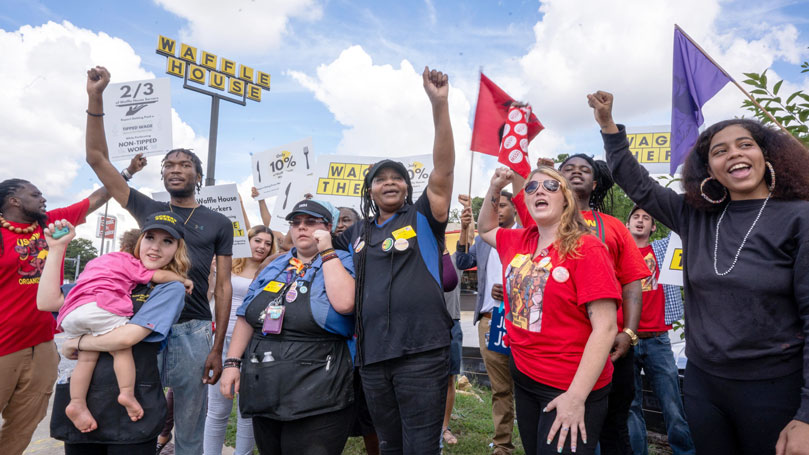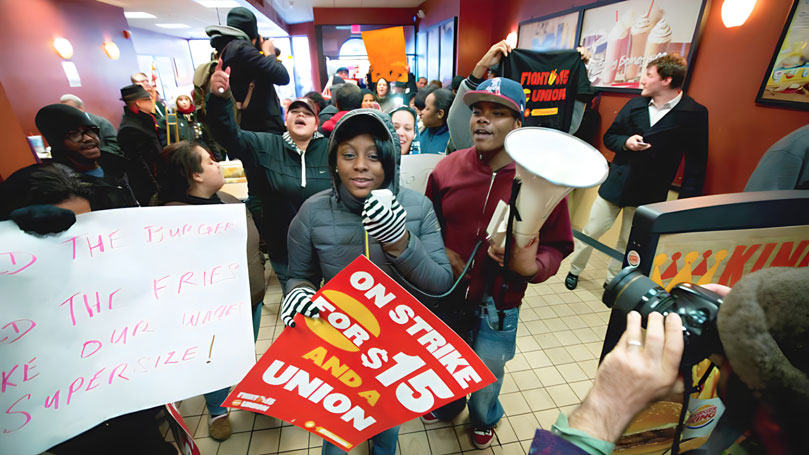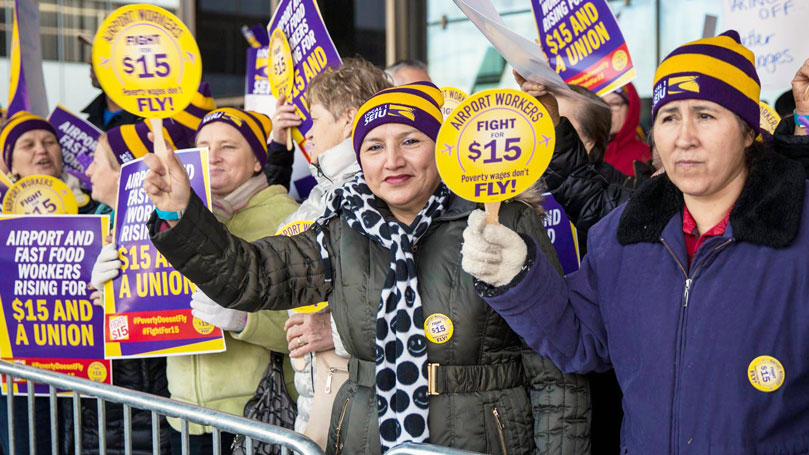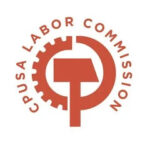
A contribution from the Service Workers’ Subcommittee of the CPUSA National Labor Commission
The Service Workers Subcommittee of the CPUSA contends that service workers are an integral part of our working class within a key site of struggle. As such, the question of how Party clubs and members should practically orient towards organizing within the service sector is of immediate importance.
The service sector’s rapid expansion within our national economy was ultimately driven by three factors: the development of industrial productivity through new technology like automation, the development of monopoly-driven financial globalization, and the brutal rout of working class forces both here and abroad. Legacies of racism and sexism also meant that as this sector expanded in the later half of the 20th century, it remained overwhelmingly non-union. This chauvinism against the service sector has even infected some sections of our working class and union movement.
Our focus does not dismiss the ultimate centrality of organizing the basic industries (steel, energy, manufacturing, etc) as an inescapable historical task. It should be seen as a complement to it and an attempt to respond to the changes in conditions in a way that strengthens overall working class organization.
Service work is not just a singular or subordinate sector; it plays a critical role in the contemporary capitalist economy and therefore complements the fight in basic industries. By employing coordinated and militant tactics from the grassroots level, service workers can leverage our power and extend working class influence into every corner of economic and political life.
Party comrades have a critical role to play in this front by contributing the “Communist plus” — what Communists add to broader struggles — a policy encouraging all members to approach organizing with self-discipline, dependability, collaboration, respect, and hard work. By building direct relationships with service workers, party members can enhance their connection to class struggle, cultivate organizing skills, and foster grassroots leadership, deepening the political impact of service worker organizing.
A key site of struggle
Historically, labor struggles in basic industrial production were seen as the frontline of class conflict. And there was a good reason for that. However, the neoliberal period in the 1970s, which saw a massive shift by the capitalist class away from industrial production towards financial forms of capital, in addition to massive leaps in technology and productivity, has radically transformed the composition of the working class. The workers who were shut out of industrial production still needed jobs and places to work to make a living. Many of these workers got jobs in the service sector to make ends meet.

While the organizational power of industrial workers in basic industries still remains central to the ultimate goal of constructing anti-monopoly and socialist forms of democracy, there are reasons to consider service worker organizing as one of the “key links in the chain” in the working class’ broader struggle for power.
- Numerical size: The service sector is the largest employment sector in the U.S. economy. According to the Bureau of Labor Statistics, as of 2023, the manufacturing sector comprised 7.7% of total employment, while retail alone accounted for 9.3%. Service work is also the fastest growing sector of our economy. (U.S. Bureau of Labor Statistics)
- Inclusive representation: The service sector workforce includes a significant proportion of women, people of color, LGBTQ people, young people, and disabled workers. This diversity reflects the broader demographics of the nation, making the sector a microcosm of society. By focusing on organizing within this sector, the party can cultivate a broad, inclusive political bloc that mirrors the nation’s diversity.
- Geographical distribution: Unlike industries concentrated in specific regions, service sector employment is widespread across urban, suburban, and rural areas. This broad distribution offers opportunities to influence political districts beyond major metropolitan centers. By organizing service workers in these varied locales, the labor movement can establish footholds in regions often overlooked, thereby enhancing political power in local and state legislatures.
- Political mobilization: Service workers, as constituents in diverse districts, can be mobilized to support pro-worker and pro-democracy candidates. Their collective action can shift political dynamics, especially in areas where labor movements have been traditionally underrepresented.
The task before us is large. On one hand, union density is less than 10%, our resources are limited relative to the scope of the task at hand, and the capitalists enjoy an overwhelming advantage in the political and legal arenas. On the other hand, popular approval of the labor movement is at historic highs, with equally high disapproval of “oligarchic” monopoly capitalism.
This balance of forces demands innovation in strategy and tactics for labor organizing. Rather than large, resource-intensive organizing campaigns focused primarily on winning union elections and contracts, worker-to-worker organizing tactics must be developed that favor fighting up to a majority, but not relying on a majority to fight. The goal is twofold:
- To cultivate a new generation of shop-floor, class struggle leaders forged in worker-to-worker organizing
- To help maintain sharp, short, and constant disruptions across the sector, developing pressure on capitalists, while building broader working class solidarity in every industry
The service sector of the economy is also a site of high employment turnover. Workers may see themselves as transient, merely passing through the industry. However, these workers are more often transient within the service sector; it is much less frequent that they leave the sector altogether. This phenomenon is often seen as a barrier to organizing, but it also can represent an important opportunity — especially as most young workers now begin working in the service industry rather than a coal mine, for example.

As the tempo of struggle spreads across the sector, workers cycling through workplaces will increasingly come into direct contact with class struggle. Many workers will even spend time as worker-leaders before moving to other workplaces. This dynamic then becomes an opportunity for workers to carry their organizing experiences with them — like seeds on the wind. This also holds for the workers who do eventually leave the service sector altogether.
Practical tasks
For party members building clubs, the service sector of our workforce offers a crucial point for applying the policy of working class concentration. It provides opportunities to develop a cadre in the labor movement, especially among young workers, which will sharpen our approach to broader struggles. The sector’s conditions demand militant, flexible tactics that foster rank-and-file leadership and a persistent disruption of business as usual.
Practically, party clubs and rank-and-file members can implement this policy of concentration by dividing their membership strategically — either adopting a few small service workplaces or dedicating groups of comrades to different departments within a larger service workplace. These smaller work-groups can then actively develop the tactics needed to build durable, mutually respectful relationships with workers, supporting their entry into struggle both at work and in the broader community.
Central to this task is the fight against chauvinism directed at the service sector, historically intertwined with sexism and racism. Party comrades have a special responsibility to champion unity, combating divisive attitudes both within the service sector itself and between service workers and other sectors of the working class.
Far from being isolated or subordinate, service work has emerged as a critical frontline in contemporary class struggle, complementing and enriching the fight in the basic industries. Through disciplined, militant rank-and-file organizing, service workers have the capacity to expand working class influence into every sector of economic and political life.
Party clubs and members play a pivotal role in this task, applying the “Communist plus” to build direct, meaningful relationships with service workers and nurture class consciousness, unity, and grassroots leadership. Rather than viewing service work as an area of degradation, we must recognize it as a vibrant field of struggle, ripe with potential for strategic breakthroughs, class solidarity, and revolutionary advancement.
Images: Waffle House workers rally to demand an end to wage theft and back pay by Union of Southern Service Workers (X); Fast food workes in Boston on strike on Dec. 4, 2014 by Fight for $15 and a Union (Facebook); Airport workers in 2016 demand $15 and a union by Laura Collins Britton (Facebook)


 Join Now
Join Now